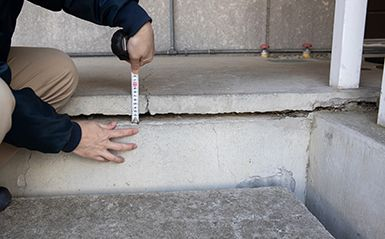If you're a homeowner or a business owner, you know that a sturdy foundation is essential for the safety and longevity of your property. Unfortunately, even the most well-built concrete foundations can develop cracks over time. While small cracks may seem like a minor inconvenience, they can quickly turn into major problems if left untreated.
At URETEK, we specialize in foundation repair and provide solutions for both commercial and residential properties. We understand the unique challenges that come with each type of property and have the expertise to address them effectively. In this blog, we'll explore the deeper problems that may be lying beneath the surface of a cracked foundation.
Commercial vs. Residential Foundation Repair
Unattended cracks in both commercial and residential buildings can have serious long-term consequences, but there are significant differences in how to approach each type.
Commercial buildings are typically larger and more complex than residential buildings, which can make foundation repairs a challenge. The sheer size and weight of a commercial building can put significant stress on the foundation, and ongoing business operations can demand an especially quick and efficient repair process.
In residential buildings, foundation problems can be just as severe as in commercial buildings. They’re often also harder to detect since many homeowners may not recognize the warning signs until the damage is already advanced.
For any type of building, a popular choice for foundation repair uses expanding polymer technology because it's quick, cost-effective, and minimally invasive. URETEK’s Deep Injection Process injects a foam of this polymer into the soil beneath the foundation, which fills any voids and stabilizes the soil. This lifts and levels the foundation, fixing any cracks or other issues.
Unlike cementitious grouting, or “mudjacking,” which involves pumping a slurry of concrete and soil into the ground, polyurethane foundation repair is much more precise and accurate, addressing the underlying cause and not just the symptoms of a problem.
Underlying Causes of Foundation Problems
If your building's foundation is beginning to crack, it could be the first warning sign of many deeper issues.
Soil Movement
The soil beneath a building is constantly in motion, expanding and contracting with changes in moisture levels. If the soil is unstable or too weak to support the building's weight, it can cause the foundation to shift and crack. Some common causes of soil movement include:
- Soil erosion
- Changes in temperature
- Settlement of nearby structures
- Poor soil compaction during construction
- Expansive soil
- Water Damage
Water Damage
Water can cause significant damage to a building's foundation if it's not properly managed. If water seeps into the soil around the foundation, it can cause the soil to erode and the foundation to shift. Common causes of water damage include:
- Poor drainage
- Plumbing leaks
- Overwatering plants near the foundation
- Improper grading of the soil
- Poor Construction
Flawed Construction
Sometimes, foundation problems can be traced back to poor construction techniques. If the foundation was not properly designed or constructed, it may be more prone to cracking and other issues. Common construction-related causes of foundation problems include:
- Improper excavation
- Incorrect reinforcement placement
- Inadequate foundation depth
- Poor soil preparation
- Invasive Tree Roots
Root Growth
Large trees near a building can cause significant damage to the foundation if their roots are allowed to grow too close. As the roots grow, they can push against the foundation, causing it to shift and crack. Invasive tree roots are a common cause of foundation problems in residential buildings.
Foundation Repair Importance
Ignoring foundation problems can lead to more severe issues in the long run, including compromised structural integrity and reduced property value. As soon as you notice any signs of foundation issues, it's important to address them as soon as possible to prevent further damage.
If you're a homeowner or business owner, regular inspections of your building's foundation can help you identify any issues before they become more severe.
Polyurethane Foundation Repair Benefits
Polyurethane foundation repair offers several advantages over other foundation repair methods. Here are some of the benefits:
- Non-invasive: Polyurethane foam is injected through small holes drilled in the foundation, making it a minimally invasive repair method.
- Quick and efficient: Polyurethane foam sets in minutes, allowing for repairs to be completed quickly and with minimal disruption to business operations or homeowners.
- Precise and accurate: Polyurethane foam expands to fill any voids beneath the foundation, providing accurate and long-lasting repairs.
- Cost-effective: Compared to traditional foundation repair methods, polyurethane foundation repair is affordable and can save homeowners and business owners money in the long run.
Conclusion
In conclusion, visible cracks on a building's foundation can indicate serious, more complex issues that need to be addressed. Soil movement, water damage, poor construction techniques, and invasive tree roots are just some of the underlying causes of foundation problems.
Whether you're a homeowner or a business owner, it's important to address foundation issues as soon as possible to prevent further damage. Don't ignore foundation problems – as we’ve shown throughout our many case studies, the issues may lie much deeper.
